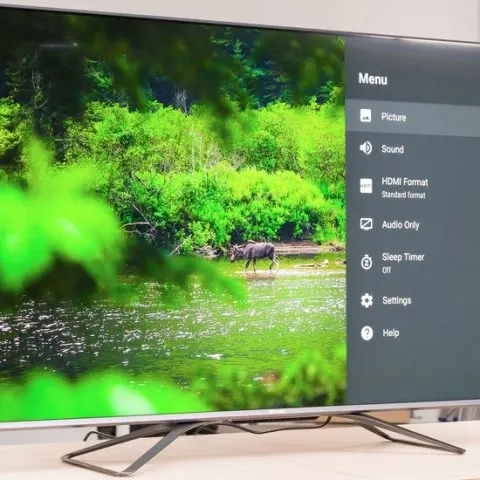You might have heard of Hisense TV, especially if you’re looking for a new and affordable smart TV. Additionally, the brand is associated with some big brands, such as Toshiba.
Here’s what you need to know about the Hisense product catalog, their location, and other electronics that they manufacture:
Where Are Hisense TVs Designed and Put Together?
Hisense TVs are designed in the US in St. Charles, Illinois, and the manufacturing process occurs in Qingdao, Shandong Province, China. However, the company sources some components from third-party manufacturers.
It’s interesting to understand that China manufactures many of the world’s TVs, including Hisense. LG and Samsung are the only two TV brands that aren’t produced in China.
Which Company Makes Hisense TVs?
Hisense TVs are manufactured by the Hisense Group, which makes both TVs and home appliances. Hisense Group is under a parent company called Hisense Visual Technology Company Limited, which was founded in 1969, and is now China’s largest television maker.
Hisense has 20 subsidiaries in China, 17 industrial parks worldwide, and 16 R&D centers across Europe, South Africa, and Central America.
In addition to their products, Hisense manufactures TVs for other brands and is involved in joint ventures with brands such as Sharp, Toshiba, and Hitachi.
Brands Owned by Hisense
Hisense makes TVs and other home appliances; therefore, the company owns a few brands. In addition, Hisense owns or licenses the following brands:
- Hisense: Hisense is the main brand of Hisense Group in electrical appliances.
- Kelon: Kelon Air Conditioning is one of the pioneers in the research, development, production, and popularization of inverter air conditioners in China.
- ASKO: ASKO is a global luxury home appliance brand that includes a series of kitchen appliances, refrigerators, detergents, and care products, offering consumers a better lifestyle.
- HITACHI: Qingdao Hisense Hitachi Air Conditioning System Co. Ltd. was founded on January 8, 2003. It was jointly invested by Hisense Group and Johnson Controls Hitachi Air Conditioning in Qingdao.
- TOSHIBA (Toshiba TVs): Toshiba was founded in 1875 and was acquired by Hisense in 2017.
- Saiwei: founded in 2002 and headquartered in Qingdao, the company focuses on electronic products, information technology, data applications, intelligent transportation, and other areas and aims to become a first-class service provider in the country.
- Gorenje: Hisense acquired a 100% share of Gorenje in 2019.
In addition to the above, Hisense obtained a Sharp manufacturing unit in Mexico. However, Sharp (now owned by Foxconn) sued Hisense in June 2017, requesting that the licensing agreement be terminated.
Sharp accused Hisense of harming its brand value by using its trademarks on “shoddily manufactured” devices, including ones that it claimed breached US safety requirements for electromagnetic radiation and fraudulent promotion of their quality.
However, Hisense denied the accusation stating it would continue to produce and sell TVs under the Sharp licensed trademarks and plans to defend itself in court.
Is Hisense a Product of LG?
Hisense and LG are developed and manufactured by two different companies. However, you might think they’re related because Hisense manufactures some products for LG.
LG utilizes Hisense for some materials, but it’s made and manufactured elsewhere. However, some of the products that LG uses are outsourced to Hisense for manufacturing.
Although LG isn’t manufactured in China, some products are outsourced from Hisense in China.
Who Makes Components for Hisense TVs?
Hisense is a vertically integrated company; therefore, it produces most of its components. However, they still rely on other third-party manufacturers for parts such as color films, chipsets, LED backlight films, and other electronic parts.
Hisense relies on other manufacturers for components like CPUs that are used in Hisense Android TVs. For example, LG, TDK, and Intel are the major component manufacturers for Hisense. In addition, LG makes OLED panels for Hisense TVs, Intel produces flash chips, and Hisense produces LCD Panels.
Are Hisense TVs Reliable?
Hisense produces budget-friendly TVs with a decent level of quality and features. As a result, many customers recommend Hisense as a great entry-level TV.
While Hisense TVs aren’t as powerful as some more expensive brands, they are still a good value. Additionally, most people who buy the TV believe it’s well worth the money.
Hisense TVs have wonderful features and great image quality for a reasonable price. Some of the brand’s excellent features include:
- Excellent ULED technology, which provides higher brightness with less power consumption.
- Hisense makes its panels, putting them ahead of competitors who rely significantly on other brands for display components.
The lifespan of Hisense TVs is comparable to that of other brands. While they might not have the same parts as higher-end brands, they tend to last longer with good care and maintenance.
An average TV has a lifespan of 4 years (40,000 hours) to 10 years (100,000 hours), depending on how you use and maintain it. However, newer TVs have an average lifespan of seven years before showing signs of damage.
Recent years have seen TV manufacturers pack their products with the latest and advanced features, providing users with the best experience. However, the advanced features have made prices go over the roof, making TVs very expensive.
Hisense has successfully provided budget-friendly TVs with good quality and decent features. The brand has also remained competitive when it comes to pricing.

